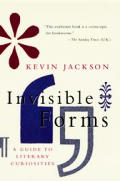
Invisible Forms:
A Guide to Literary Curiosities
By Kevin Jackson
iRead
By Jeanne Doherty, MLIS
One of my favorite shelves at the bookstore is the (usually tiny) one devoted to “Books on Books.” The best examples of this genre attempt to intelligently and entertainingly communicate some of the more obscure aspects of literature and of the bookish life to the common reader. This particular book is dedicated to the exploration of the various forms of para-text: footnotes, titles, epigraphs and various other near-essential, but often overlooked technical aspects of printed literature. This may sound like dry and dull stuff, and no doubt some enterprising person could make it into something dry and dull, but Kevin Jackson does just the opposite. In fact I was laughing so helplessly and so frequently, that my sweetheart asked me to "please read in the other room, I was making it impossible for him to concentrate." My penchant for reading all of the funny bits out loud couldn't have helped, as there were at least two on every page.
Jackson goes out of his way to explain that this is not a scholarly work, somewhat disingenuously, I might add, as it is clear from the sheer volume of citations in the book that he has definitely done his homework. What he has not done is sacrificed clarity or humor in the pursuit of precision. How this makes the work not scholarly is anyone's guess, but I am sure some of the (almost purely mythical) locked-in-their-ivory-tower scholars could explain it to me. In my opinion, the best scholarship is that which makes itself accessible to everyone, by which I don't mean that it dumbs itself down, but that it clears away some of the obfuscation that seems to plague publications that are written only for other (competing) experts. Call me crazy, but I believe that any concept accessible to one human can be explained in such a way as to engage the interest and intelligence of another. This book is a stellar example of just that kind of explanation, putting it into such illustrious company as The Quark and the Jaguar by Murray Gell-Mann, The Copernican Revolution by Thomas S. Kuhn and The Elizabethan World Picture by E. M. W. Tillyard. It's a noble pursuit, that of making knowledge accessible to the masses, and I suspect that it is also enjoyable. Invisible Forms definitely benefits from its author's sense of play and keen ear for a good joke. There is no doubt in my mind that the task of writing the book was fun for him and he makes reading it fun for us.
